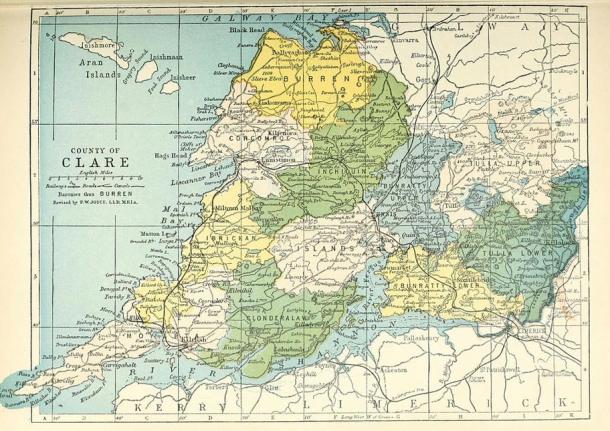
The Graveyard of the Lost: Why Hundreds of Children were Buried in an Old Irish Ring Fort
Inside the ring fort at Tullycrine in West Clare, Ireland, visitors can see the graves of hundreds of children dating from a period in Irish history when those who had not been baptized were banned from being buried in consecrated ground.
The burials were performed in accordance with the rule of the 5th Century St Augustine of Hippo, who declared that the souls of unbaptized infants were condemned to hell because of the original sin. This rule was relaxed to a degree later but Rome still dictated who could or couldn’t receive a proper Christian burial. This meant that sites such as the ring fort at Tullycrine became communal graveyards for children who died before being baptized.
Each child’s grave is marked by tiny flagstones. The burials are known as Cillins, or Cillini, and they can be found all over rural Ireland. In some cases, local towns are named after them, such as Killeen in County Armagh. The first academic references to these places occur in the works of 19th century antiquarians. In 1939, Seán O’Súilleabhaìn wrote in an article that even in Pagan times, children who died early on in their lives were buried in a separate location, away from adults. The Cillini were often situated near a holy well or sometimes near a crossroads or on a boundary line.

Map of County Clare, Ireland (Wikimedia Commons)
The burial ceremonial given to the children was a somewhat ritualistic affair taking place at night with only men in attendance.
“Other family members were not encouraged to recognize the birth of the child or to accompany it on its final journey” said Flan Kelly, a local farmer, speaking to The Irish Examiner:
“That was how it was in those days. And this is a tradition which continued up until the fifties and perhaps the sixties. We have no exact records, but we estimate that there are hundreds of graves in the fort. It is unusual for these types of graves to be found inside a fort given all the past belief of the fairies residing in them. But perhaps it was because of this very point that people buried the babies here. By doing so they were putting them in a place they knew would never be disturbed by farmers. But it is not just babies who are buried here; we believe that many adults, the likes of farmer laborers or people who died on the roadside during the famine and were never claimed by their families are also in here.”
- The Wooing of Etain: An Irish Tale of Love, Loss, and Jealousy
- Ancient bog body found in Ireland may be Iron Age sacrifice
- Legendary Lia Fáil - The Coronation of High Kings in Ancient Ireland
- Burials uncovered in Ireland reflect fusion of Paganism and Christianity
Mr. Kelly, with the assistance of John Deeley and the Kilmurry McMahon Heritage society, has worked hard to ensure the burials are not forgotten by future generations. The site is protected from wandering livestock by an electrified barbed wire fence and land and a short stretch of roadway have been acquired to enable public access. A memorial plaque has also been erected and in 2008 the space was given a blessing by the then Bishop of Killaloe, Willie Walsh.

The plaque at the Children’s Fort / Children’s Burial Ground, Tullycrine, West Clare, Ireland (Irish Examiner)
“LiosnaLeanaí reminds us of a time when there was a much harsher vision of God and a very hard understanding of God as a harsh judger” Mr. Walsh said. “We have been fortunate enough to live, if you like, in a less harsh time and in times too where we truly believe that our God is the God of love. Thankfully over the years I think we have improved our understanding of God.”
Not far away is Tullycrine’s Holy Well which is known as Tobergrowata Holy Well of TobarnaRabhartaí on old Ordinance Survey maps. These days it is more popularly known as St Mary’s well. As with other such sites across the British Isles, it is incredibly old and may have been originally sunk in pre-Christian times. However, such wells were later embraced by rural society when the British tried to crush Irish Catholicism.

The Tullycrine Holy Well, Tullycrine, Ireland (Janet/Blogging from the Bog)
“There are many wells like this in West Clare” Mr. Kelly adds:
“When the British were in Ireland, they did away with the churches so people would come to places like these wells to keep their religion alive. But once people were allowed to return to churches again, these types of wells were by and large forgotten about. I was renting the land here about 15 years ago and discovered the well again. It was all overgrown with rushes; all that was left was a barrow of stones and a small statue of the Blessed Virgin. The water was overflowing and it was in a very, very bad way.”
Kelly and Deeley helped to clear the site and a committee was established with a fundraising campaign. This in turn generated interest among the local community and the Holy Well is now used on a regular basis with benediction and rosary on the last Sunday in May and rosary every Sunday throughout October.
- Grace O’Malley, the 16th Century Pirate Queen of Ireland
- Was Dracula Story inspired by Abhartach, the Bloodsucking Chieftain of Ireland?
- Myth and mystery of the Blarney Stone has been shattered by new research
- The Day of St Patrick and the myth of snakes being cast out of Ireland
People often believed that these ancient wells were places of healing. The Department of Irish Folklore Primary Schools Project (1937-38) records old tales associated with them, such as that of a woman whose eye sight was restored after visiting the well at Tullycrine. Other stories say that the well moved its location from time to time, disappearing and then appearing again in another part of the field.
Perhaps it was the fairies, the fair folk often mentioned in rural stories as being associated with such tricks. Who can say for sure...?
Featured Image: Small grave at the Children’s Fort in Tullycrine, Ireland (Janet/Blogging from the Bog)
By: Robin Whitlock
















Comments
Seeing the Irish Cross in the last picture reminded me of a video I watched recently. It claims that the Irish Cross started as a math and navigation tool.
https://www.youtube.com/watch?v=OS4W6Jfgj0c